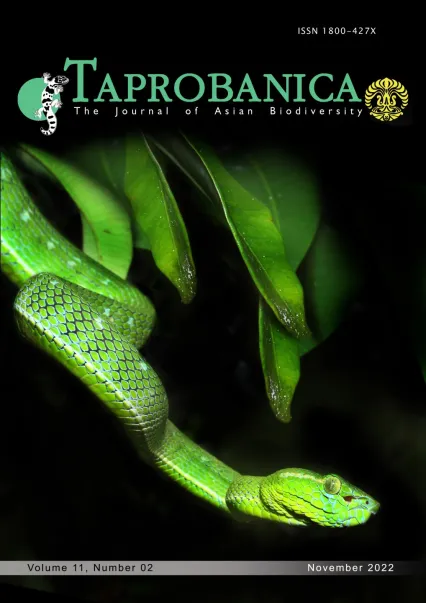

v11i2.290
Volume 11 | Number 2 | November 2022
Short Note
ISSN: 1800-427X (printed)
eISSN: 1800-427X (online)
DOI:10.47605/tapro.v11i2.290
Submitted date: 20 March 2022
Accepted date: 29 October 2022
Published date: 22 November 2022
Pp. 109–110, Pl. 34.
Biofluorescence in the masked palm civet (Paguma larvata)
A. Borzée* & Z.Q. Wang
*Corresponding author. E-mail: amaelborzee@gmail.com
Biofluorescence has come to general public attention over the last decade with the industrial production of “black lights”. While numerous reports on biofluorescence have become available for some groups of species such as invertebrates, birds, amphibians, and reptiles, there are fewer reports on fluorescence in mammals. So far, ultraviolet fluorescence is known from a few mammal species only, including flying squirrels, mice, Chinese pangolins, Virginia opossums and other didelphid marsupials, springhares, African pygmy hedgehogs, European hedgehogs, and platypuses. The fluorescence is, however, not produced by the animal itself in the case of hedgehogs, but by commensal bacteria. Green fluorescence can also be expressed by transgenic animals, including non-human primates, and the trait can become inheritable.
Section Editor: Lee Harding
eISSN: 1800-427X (online)
DOI:10.47605/tapro.v11i2.290
Submitted date: 20 March 2022
Accepted date: 29 October 2022
Published date: 22 November 2022
Pp. 109–110, Pl. 34.
Biofluorescence in the masked palm civet (Paguma larvata)
A. Borzée* & Z.Q. Wang
*Corresponding author. E-mail: amaelborzee@gmail.com
Biofluorescence has come to general public attention over the last decade with the industrial production of “black lights”. While numerous reports on biofluorescence have become available for some groups of species such as invertebrates, birds, amphibians, and reptiles, there are fewer reports on fluorescence in mammals. So far, ultraviolet fluorescence is known from a few mammal species only, including flying squirrels, mice, Chinese pangolins, Virginia opossums and other didelphid marsupials, springhares, African pygmy hedgehogs, European hedgehogs, and platypuses. The fluorescence is, however, not produced by the animal itself in the case of hedgehogs, but by commensal bacteria. Green fluorescence can also be expressed by transgenic animals, including non-human primates, and the trait can become inheritable.
Section Editor: Lee Harding
- List of Articles & Contents





